Pieter Brueghel the Younger
Pieter Brueghel (also Bruegel or Breughel)[lower-alpha 1] the Younger (/ˈbrɔɪɡəl/,[2][3] also US: /ˈbruːɡəl/;[4][5] Dutch: [ˈpitər ˈbrøːɣəl] ⓘ; between 23 May and 10 October 1564 – 1637/38) was a Flemish painter known for numerous copies after his father Pieter Bruegel the Elder's work, as well as original compositions and Bruegelian pastiches. The large output of his studio (some 1,400 pictures exist with plausible links to Brueghel and his shop[6]), which produced for the local and export market, contributed to the international spread of his father's imagery.
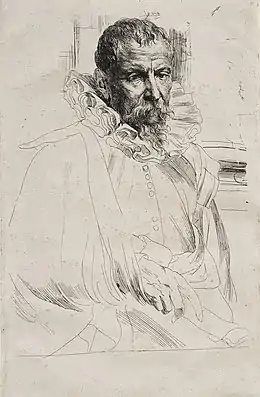
Traditionally Pieter Brueghel the Younger has been nicknamed "de helse Brueghel" or "Hell Brueghel" because it was believed he was the author of several paintings with fantastic depictions of fire and grotesque imagery. These paintings have now been attributed to his brother Jan Brueghel the Elder.[7][8]
Life
Pieter Brueghel the Younger was born in Brussels, the oldest son of the famous sixteenth-century Netherlandish painter Pieter Brueghel the Elder (known as "Peasant Brueghel") and Mayken Coecke van Aelst. His father died in 1569, when Pieter the younger was only five years old. Following the death of his mother in 1578, Pieter, together with his brother Jan Brueghel the Elder (also referred to as "Velvet Brueghel", "Paradise Breughel" and "Flower Breughel") and sister Marie, were raised by their grandmother Mayken Verhulst in a property in the centre of Brussels that was owned by her family.[9] Mayken Verhulst was the widow of the prolific artist Pieter Coecke van Aelst and an accomplished artist in her own right, known for her miniature paintings.[10] According to the biographer and art theorist Karel van Mander, who published a 'Life' of Pieter Bruegel the Elder in his 1604 Schilder-boeck (Painter Book), Mayken Verhulst provided her grandson Jan with artistic training;[7][11] and, on that basis, it is eminently reasonable to propose that Pieter also received an initial artistic instruction from his maternal grandmother.[12]

Early in 1583, Pieter moved to Antwerp, soon followed by his grandmother and brother Jan.[12] Pieter seems to have entered the studio of the landscape painter Gillis van Coninxloo (1544–1607), who was related to the Brueghel family through marriage[13] – the register (liggeren) of Antwerp's painters' Guild of St Luke for 1585–86 lists Gillis followed immediately by 'Peeter, his cousin and apprentice' ('Peeter, syn cosyn ends cnecht').[14] His teacher left Antwerp in 1585 and in the 1584/1585 registers of the Guild of Saint Luke, "Peeter Brugel" is listed as an independent master, enlisting as a 'free master's son' (vrymeestersson).[15]
It is not known exactly when Brueghel established his own independent studio following his Guild matriculation – his first surviving dated painting comes from several years later, in 1593.[16] It is however known that from 1589 he was established in a house in Antwerp located on the Bogaardestraat, near to the junction with Sint-Antoniusstraat. The house, which he rented, was located in a poorer part of town, nestled amongst small shopkeepers' houses and at least one brothel, and comprised a front and rear building containing a large studio where Brueghel could work, store materials and, presumably, finished works.[17] He lived at the property with his wife Elisabeth Goddelet, whom he married in 1588 and with whom he had seven children between 1589 and 1597, many of whom died young.[16] One son called Pieter Brueghel III was also a painter.[10] The family lived at this property until at least May 1609, before relocating, at some point before 1616, to the more affluent area on the Brabantse Korenmarkt behind the Tapestry Hall.[17]
Nine formal apprentices, including Frans Snyders and Andries Daniels, passed through Brueghel's workshop between 1588 and 1626/27.[18][11] Many other artists must have found work in his studio as 'journeymen' – peripetetic jobbing artists hired by day or by contract without need of Guild registration. With an average of one or two formal apprentices every few years, and perhaps several journeymen at any one time, Brueghel thus had a relatively large workforce at his disposal to assist with his prodigious output.[19]
The precise date of Brueghel's death is not known. His name appears in the register of Antwerp's Guild of St. Luke in a section recording funerary debts for the year 1638, indicating that he died during the Guild year 1637–38.[20]
Work
General
Pieter Brueghel the Younger painted landscapes, religious subjects, proverbs, and village scenes. A few flower still-life paintings by Pieter have been recorded.[1] His genre paintings of peasants emphasize the picturesque and are regarded by some as lacking Pieter the Elder's subtlety and humanism.[21]
He and his workshop were prolific copyists of Pieter Bruegel the Elder's most famous compositions. His name and work were largely forgotten in the 18th and 19th centuries until he was rediscovered in the first half of the 20th century.[11]
Original works

Pieter Brueghel the Younger created original works largely in the idiom of his father which are energetic, bold and bright and adapted to the 17th-century style.[11] One of the artist's most successful original designs was the painting of The Village Lawyer (sometimes also called the Tax Collector's Office, the Payment of the Tithe, the Lawyer of Bad Cases and the Notary's Office). The different titles of the work indicate that it may have been interpreted in these different ways in the 17th century. The title The Village Lawyer is probably the best suited since the person behind the desk is wearing a lawyer's bonnet, the collection of taxes usually did not occur in such setting and the paperwork and bags on the desk look like those for requests and decrees. The picture also shows peasants lining up with presents such as chickens and eggs to please the lawyer, which was a common occurrence, whereas tithe payments were made in grain.[22] The painting shows his interest in and close observation of village life. Pieter Brueghel the Younger's workshop made many copies of the composition in different formats. There exist 19 signed and dated versions of this work (from between 1615–22) out of some 25 originals and 35 questionable versions.[18]
Another original composition of Pieter Brueghel the Younger is the Whitsun Bride, which is known in at least five autograph versions.[11] One of the copies was formerly held by the Metropolitan Museum of Art. The picture depicts a Flemish springtime custom of choosing and crowning a queen at Whitsuntide. The festival is focused around a flower gathered in the fields by children. This painting distinguishes itself in style and colour clearly from his father's work. The painting uses bright colours, with much vermilion and a rich blue-green in the figures and blue for the sky. The colours display a unity of tone distinctive of the 17th century. The picture also displays a unity in drawing and composition.[23] Another original composition by Pieter Brueghel the Younger are four small tondos representing the Four Stages of the River (all at the National Gallery in Prague). As his style never evolved from the manner of his early career it is difficult to date his work.[11]
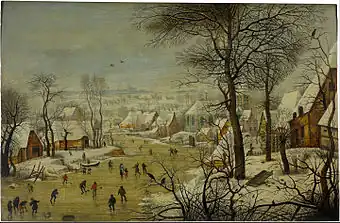
In several cases, it is not clear whether a composition is an original composition by Pieter Brueghel the Younger or a copy after a lost work by his father.[18]
Copyist
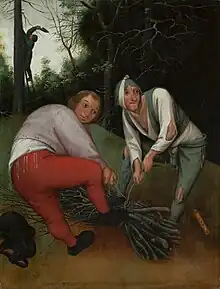
Apart from these paintings of his own invention, Pieter Brueghel the Younger also copied the famous compositions of his father through a technique called pouncing. This large scale activity was only possible thanks to his large, well-organized workshop. Comparison of some copies with the originals reveals differences, both in terms of colour as well as the omission or addition of certain details. This may indicate that the copyist re-drafted some sections, or possibly based the copies on prints after original works, rather than on the originals themselves.[24] Pieter the Younger frequently made paintings out of his father's figural designs, including drawings for prints.[8]

As Pieter Brueghel the Younger did not always have access to the original paintings of his father he would in fact often rely on prints of his father's work to create his derived compositions.[11] He also had access to (now lost) compositional drawings and intermediary cartoons which his father had made and then transferred to panels using pouncing.[25] His work is often the only source of knowledge about works of his father that are lost.[11] One example of just such a work is the Two Peasants Binding Firewood, of which several autograph versions exist (Barber Institute of Fine Arts; Private Collection), alongside various studio productions and even copies made outside the Brueghel workshop, which seems to preserve a now-lost original composition by the Elder Bruegel.[26]
The subjects of the copied works cover the entire range of themes and works by Pieter the Elder, including specific religious compositions on both the grand and the small scale. The principal subjects are proverb and peasant scenes of his father.[18]
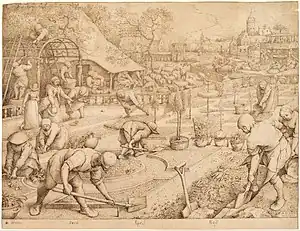
_-_The_four_seasons%252C_spring_(Bukarest).jpg.webp)
One of the most frequently copied works of his father was the Winter Landscape with Skaters and a Bird-trap. This work was reproduced by Pieter Brueghel the Younger and his workshop at least 60 times. Of these copies 10 are signed and 4 are dated (1601, 1603, 1616 and 1626). Another popular work of Pieter the Elder was the Adoration of the Magi in the Snow of which Pieter Brueghel the Younger and his workshop produced about 30 copies.
The workshop also produced no less than 25 copies of Pieter Brueghel the Elder's St John the Baptist Preaching, the original of which is widely believed to be the picture dated 1566, in the Museum of Fine Arts in Budapest.[27] Some of the copies are held in the collections of museums such as the Hermitage, the Royal Museum of Fine Arts in Antwerp, the National Museum in Kraków, the Rheinisches Landesmuseum in Bonn, the Stedelijk Museum Wuyts-Van Campen en Baron Caroly in Lier and the Musée des Beaux-Arts de Valenciennes. Some of the copies are signed and dated.[28][29][30] The quality and the large number of versions produced by Brueghel the Younger suggest that he had first-hand knowledge of his father's original. Scholars have contended that Brueghel the Elder's original picture offered a coded comment on the religious debates that raged in the Low Countries during the 1560s and that it represented a clandestine sermon as held by the Protestant reformers of that time.[27]
Pieter the Younger changed some details of his father's original composition. For instance, some versions omit an unidentified figure of a bearded man in black, who is turned towards the spectator. The omission appears to confirm speculation that his prominent presence in the original composition was not accidental.[11] The distinctive face of this figure suggests that it may be a portrait, possibly of the artist himself or the patron who commissioned the painting. The figure of Christ has often been identified either as the man in grey behind the left arm of the Baptist or the bearded man further to the left with his arms crossed. The continued popularity of the picture a generation after Pieter Brueghel the Elder's death when the subject had not only lost its political implications but ran contrary to the religious current of the time, shows there was a more aesthetic appreciation of the subject. The composition was then likely enjoyed more for its representation of humanity in all its diversity of race, class, temperament and attitude.[27]
- The Preaching of St. John the Baptist
 The Preaching of St. John the Baptist, original by Pieter Bruegel the Elder (1566), Museum of Fine Arts (Budapest)
The Preaching of St. John the Baptist, original by Pieter Bruegel the Elder (1566), Museum of Fine Arts (Budapest)_-_St_John_the_Baptist_Preaching%252C_Groeningemuseum.jpg.webp) Copy by Pieter Brueghel the Younger of his father's work The Preaching of St. John the Baptist (after 1616), Groeningemuseum in Bruges, omitting the bearded man in black, turned towards the spectator in the original
Copy by Pieter Brueghel the Younger of his father's work The Preaching of St. John the Baptist (after 1616), Groeningemuseum in Bruges, omitting the bearded man in black, turned towards the spectator in the original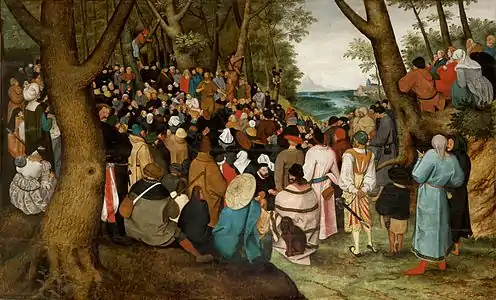
- The Alchemist
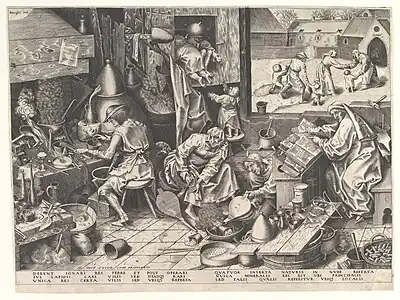 The Alchemist by Pieter Bruegel the Elder, Metropolitan Museum of Art, original etching
The Alchemist by Pieter Bruegel the Elder, Metropolitan Museum of Art, original etching Copy of The Alchemist by Pieter Brueghel the Younger recreated in colour on panel
Copy of The Alchemist by Pieter Brueghel the Younger recreated in colour on panel
The large-scale production of copies of his father's oeuvre demonstrates that there was a significant demand for Pieter the Elder's work. At the same time the copies contributed to the popularisation of Pieter the Elder's idiom. Without the son's copying work the public would not have had access to his father's work, which was mainly held in elite private collections, such as the imperial collection of Rudolf II in Prague or the Farnese collection in Parma. At the same time Pieter the Younger extended his father's repertoire through his own inventions and variations on themes by his father.[18]
Selected works
_-_IMG_7406.JPG.webp)

- A Country Brawl
- A Village Festival
- Adoration of the Magi
- Census in Bethlehem
- Flemish Proverbs
- Massacre of the Innocents
- Peasant Wedding Dance
- Saint John's Dancers in Molenbeeck'
- The Alchemist
- The Crucifixion
- The Faithless Shepherd
- The Holy Family with St John
- The Procession to Calvary
- The Sermon of Saint John the Baptist
- The Seven Acts of Mercy
- The Village Lawyer
- The Visit to the Farm
- Village Fair
- Winter Landscape with a Bird Trap
Family tree
| |||||||||||||||||||||||||||||||||||||||||||||||||||||||||||||||||||||||||||||||||||||||||||||||||||||||||||||||||||||||||||||||||||||||||||||||||||||||||||||||||||||||||||||||||||||||||||||||||||||||||||||||||||||||||||||||||||||||||||||||||||||||||||||||||||||||||||
|
| |||||||||||||||||||||||||||||||||||||||||||||||||||||||||||||||||||||||||||||||||||||||||||||||||||||||||||||||||||||||||||||||||||||||||||||||||||||||||||||||||||||||||||||||||||||||||||||||||||||||||||||||||||||||||||||||||||||||||||||||||||||||||||||||||||||||||||
Notes
- Before 1616 he signed his name as Brueghel and after 1616 as Breughel.[1]
References
- "Pieter Brueghel (II)" (in Dutch and Middle Dutch). Netherlands Institute for Art History.
- "Brueghel". Collins English Dictionary. HarperCollins. Retrieved 10 August 2019.
- "Bruegel". Lexico UK English Dictionary. Oxford University Press. Archived from the original on 22 March 2020.
- "Brueghel". The American Heritage Dictionary of the English Language (5th ed.). HarperCollins. Retrieved 10 August 2019.
- "Brueghel". Merriam-Webster.com Dictionary. Retrieved 10 August 2019.
- Catalogued by Klaus Ertz: Pieter Brueghel der Jüngere (1564–1637/38). Die Gemälde mit kritischem Oeuvrekatalog, Lingen, 1998–2000, 2 vols.
- Alexander Wied and Hans J. Van Miegroet. "Jan Breughel I." Grove Art Online. Oxford Art Online. Oxford University Press. Web. 11 July 2014.
- Larry Silver, Peasant Scenes and Landscapes: The Rise of Pictorial Genres in the Antwerp Art Market, University of Pennsylvania Press, 4 Jan 2012, p. 154–158
- Bastiaensen, Jean (2016). "Waar woonde Pieter Bruegel de Oude in Brussel?". Openbaar Kunstbezit Vlaanderen. 53: 22–27.
- Frans Jozef Peter Van den Branden, Geschiedenis der Antwerpsche schilderschool, Antwerpen, p. 440–443 (in Dutch)
- Alexander Wied and Hans J. Van Miegroet. "Bruegel." Grove Art Online. Oxford Art Online. Oxford University Press. Web. 11 July 2014.
- Edwards, Jamie L. (2022). Peasants and Proverbs: Pieter Brueghel the Younger as Moralist and Entrepreneur. London and Chicago: Paul Holberton and University of Chicago Press. pp. 9–10. ISBN 978-1-913645-39-7.
- Miedema, Hessel (1994–1996). Karel van Mander: The Lives of the Most Illustrious Netherlandish and German Painters (in Dutch and English). Doornspijk: Davao. pp. 265–66, vol. 3. ISBN 9070288850.
- Rombouts and Van Lerius, Philippe-Félix and Théodore François Xavier (1864–1876). Der Liggeren en andere historische archieven der Antwerpsche sint Lucasgilde (in Dutch). Antwerp and The Hague: Baggerman. p. 303, vol. 1.
- Rombouts and Van Lerius, Philippe-Félix and Théodore François Xavier (1864–76). Der Liggeren en andere historische archieven der Antwerpsche sint Lucasgilde (in Dutch). Antwerp and The Hague: Baggerman. p. 292, vol. 1.
- Currie and Allart, Christina and Dominique (2012). The Brueg[H]el Phenomenon. Paintings by Pieter Bruegel the Elder and Pieter Brueghel the Younger with a Special Focus on Technique and Copying Practice. Brussels: Brepols. pp. 50, vol. 1.
- For discussion, with further references, see Edwards, Jamie L. (2022). Peasants and Proverbs: Pieter Brueghel the Younger as Moralist and Entrepreneur, pp 11.
- Larry Silver, Peasant Scenes and Landscapes: The Rise of Pictorial Genres in the Antwerp Art Market, University of Pennsylvania Press, 4 Jan 2012, p. 196-207
- For discussion, with further references, see Edwards, Jamie L. (2022). Peasants and Proverbs: Pieter Brueghel the Younger as Moralist and Entrepreneur, p. 11–12.
- Rombouts and Van Lerius, Philippe-Félix and Théodore François Xavier (1864–76). De Liggeren en andere historische archieven der Antwerpsche sint Lucasgilde. Antwerp and The Hague. pp. 97, vol. 2.
{{cite book}}: CS1 maint: location missing publisher (link) - Gibson, Michael. "A Dynasty of Painters: Belgium Celebrates the Bruegels". ARTnews (January 1981): 130.
- Natalie Zemon Davis, The Gift in Sixteenth-century France, University of Wisconsin Press, 2000
- Margaretta M. Salinger, The Whitsun Bride by Pieter Brueghel the Younger, in: Bulletin of the Metropolitan Museum of Art, XXXIV (1939), p. 88-90
- "Pieter Brueghel Młodszy "Kazanie św. Jana Chrzciciela"". muzeum.krakow.pl. Archived from the original on 14 July 2014. Retrieved 8 July 2014. (in Polish)
- Odilia Bonebakker, Review of Christina Currie and Dominique Allart, The Brueg(H)el Phenomenon. Paintings by Pieter Bruegel the Elder and Pieter Brueghel the Younger with a Special Focus on Technique and Copying Practice Archived 14 July 2014 at the Wayback Machine (Scientia Artis, 8). Brussels: Royal Institute for Cultural Heritage, 2012. 3 vols, fully illus. ISBN 978-2-930054-14-8. in: historian of netherlandish art
- See the catalogue for the 2022 exhibition held at the Barber Institute of Fine Arts, edited by Robert Wenley and with essays by Jamie L. Edwards, Christina Currie and Ruth Bubb: Peasants and Proverbs: Pieter Bruegel the Younger as Moralist and Entrepreneur, London and Chicago, 2022.
- Pieter Brueghel II (Brussels 1564/5-1637/8 Antwerp), Saint John the Baptist Preaching to the Multitude at Christie's
- St John the Baptist Preaching at the Netherlands Institute for Art History (in Dutch)
- "Pokaz obrazu "Kazanie św. Jana Chrzciciela" Pietera Brueghla Młodszego". culture.pl. Retrieved 8 July 2014.
Kopia z początku XVII wieku pokazywana w Pałacu Biskupa Erazma Ciołka jest w całości dziełem syna - Pietera Brueghla Młodszego - i została zakupiona w 1963 roku przez Muzeum Narodowe w Krakowie.
(in Polish) - Magdalena Sobczyk, The recent restoration of the Groeningemuseum’s copy of The Sermon of Saint John the Baptist at Codart
External links
 Media related to Pieter Brueghel (II) at Wikimedia Commons
Media related to Pieter Brueghel (II) at Wikimedia Commons
_-_Portrait_of_Pieter_Brueghel_(I)_-_1572_-_RP-P-1907-593_cropped.jpg.webp)